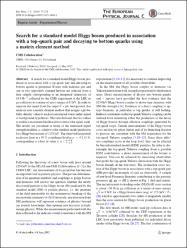| dc.contributor.author | Khachatryan, V. | |
| dc.contributor.author | Sirunyan, A. M. | |
| dc.contributor.author | Tumasyan, A. | |
| dc.contributor.author | Adam, W. | |
| dc.contributor.author | Bergauer, T. | |
| dc.contributor.author | Dragicevic, M. | |
| dc.contributor.author | Özdemir, Kadri | |
| dc.contributor.author | CMS Collaboration | |
| dc.date.accessioned | 2021-06-05T20:01:10Z | |
| dc.date.available | 2021-06-05T20:01:10Z | |
| dc.date.issued | 2015 | |
| dc.identifier.issn | 1434-6044 | |
| dc.identifier.issn | 1434-6052 | |
| dc.identifier.uri | https://doi.org/10.1140/epjc/s10052-015-3454-1 | |
| dc.identifier.uri | https://hdl.handle.net/20.500.12960/1069 | |
| dc.description | PubMed: 26097407 | en_US |
| dc.description | WOS:000355937400002 | en_US |
| dc.description.abstract | A search for a standard model Higgs boson produced in association with a top-quark pair and decaying to bottom quarks is presented. Events with hadronic jets and one or two oppositely charged leptons are selected from a data sample corresponding to an integrated luminosity of 19.5 fb(-1) collected by the CMS experiment at the LHC in pp collisions at a centre-of-mass energy of 8 TeV. In order to separate the signal from the larger t (t) over bar + jets background, this analysis uses a matrix element method that assigns a probability density value to each reconstructed event under signal or background hypotheses. The ratio between the two values is used in a maximum likelihood fit to extract the signal yield. The results are presented in terms of the measured signal strength modifier, mu, relative to the standard model prediction for a Higgs boson mass of 125 GeV. The observed (expected) exclusion limit at a 95% confidence level is mu < 4.2 (3.3), corresponding to a best fit value <(mu)over cap> = 1.2(-1.5)(+1.6). | en_US |
| dc.language.iso | eng | en_US |
| dc.publisher | Springer | en_US |
| dc.relation.ispartof | European Physical Journal C | en_US |
| dc.rights | info:eu-repo/semantics/openAccess | en_US |
| dc.subject | Fizik | en_US |
| dc.subject | Physics | en_US |
| dc.title | Search for a standard model Higgs boson produced in association with a top-quark pair and decaying to bottom quarks using a matrix element method | en_US |
| dc.type | article | en_US |
| dc.authorid | 0000-0002-0103-1488 | |
| dc.department | Mühendislik Fakültesi, Elektrik-Elektronik Mühendisliği Bölümü | en_US |
| dc.contributor.institutionauthor | Özdemir, Kadri | |
| dc.identifier.doi | 10.1140/epjc/s10052-015-3454-1 | |
| dc.identifier.volume | 75 | en_US |
| dc.identifier.issue | 6 | en_US |
| dc.relation.publicationcategory | Makale - Uluslararası Hakemli Dergi - Kurum Öğretim Elemanı | en_US |

















